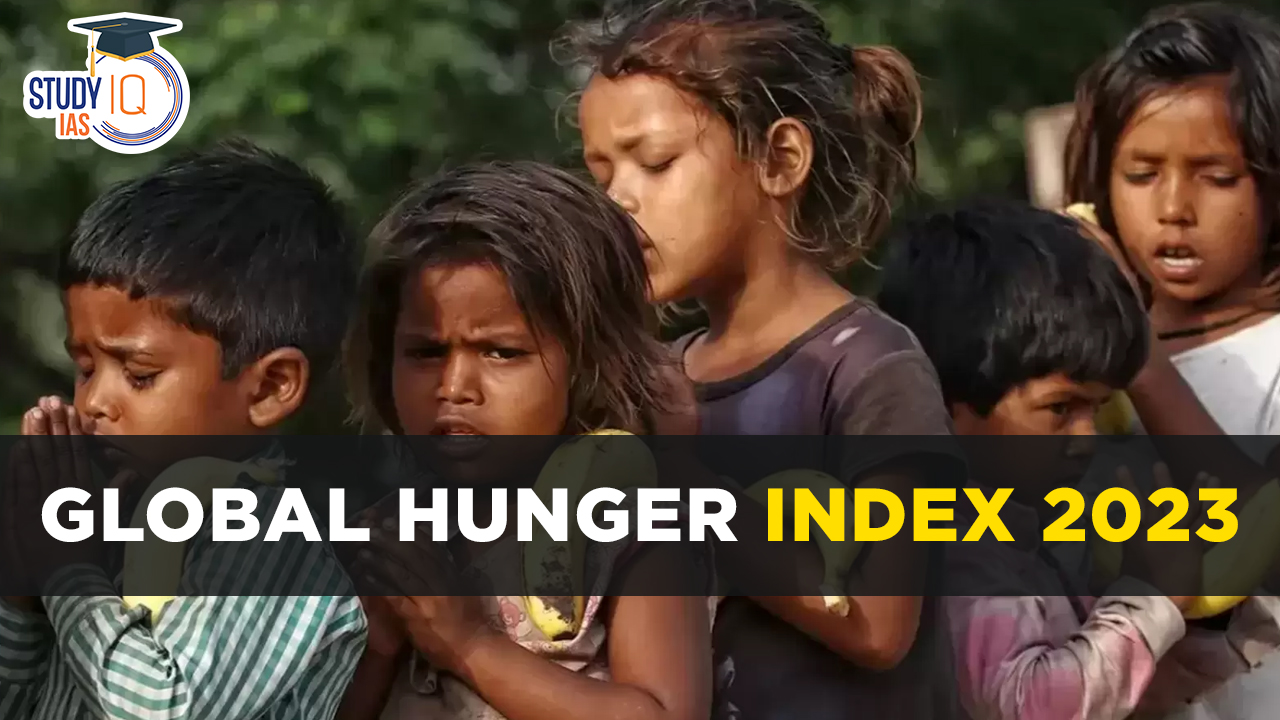Table of Contents
Global Hunger Index 2023
In the Global Hunger Index 2023, India’s ranking dropped to 111 out of 125 countries, following a position of 107 out of 121 countries in 2022. However, the Indian government has rejected this ranking, stating that it is a flawed measure of hunger and does not accurately represent the country’s actual situation.
Global Hunger Index 2023 India Ranking
Declining Rankings: India has been ranked 111 out of 125 countries in the Global Hunger Index 2023, marking a further decline from its 2022 ranking of 107 out of 121 countries.
Global Hunger Index 2023 Findings for India
- Child Wasting Rate: The GHI 2023 reported India’s child wasting rate at 18.7%, which is the highest in the world for the period 2018-2022. This alarming statistic reflects acute undernutrition among Indian children.
- Undernourishment and Under-five Mortality: The rate of undernourishment in India stood at 16.6%, and the under-five mortality rate was 3.1%. These figures signify significant challenges in providing adequate nutrition and healthcare to the population.
- Prevalence of Anemia in Women: The report also highlighted that 58.1% of women aged 15 to 24 in India suffer from anaemia, indicating a substantial health concern among young women.
- Overall GHI Score: India received an overall GHI score of 28.7, categorizing the country’s hunger situation as “serious” according to the report.
Comparison with Neighboring Countries
India’s Neighbors: In the GHI 2023, neighbouring countries of India, including Pakistan (102), Bangladesh (81), Nepal (69), and Sri Lanka (60), outperformed India in the index, indicating relative improvements in addressing hunger.
Indian Government’s Response Against Global Hunger Index 2023
- Rejection of Ranking: The Indian government has rejected the GHI 2023 ranking, asserting that it is an inaccurate measure of hunger that fails to represent India’s true situation.
- Critique of Methodology: The government criticized the methodology of the GHI 2023, citing “serious methodological issues” and suggesting a malicious intent. They noted that three out of the four indicators used in the index pertain to child health and may not be representative of the entire population.
- Sample Size Concerns: The government expressed concern about the fourth and crucial indicator, “Proportion of Undernourished (PoU) Population,” which is based on a small sample size of 3,000, and considered this sample size insufficient for a comprehensive assessment.
- Discrepancies with Data: The government pointed out discrepancies between the GHI 2023 data, such as the child wasting rate, and data from the Poshan Tracker, which consistently reported a lower rate, below 7.2% on a monthly basis.
- Child Mortality Dispute: Lastly, they disputed the assertion that child mortality is directly tied to hunger, indicating a difference of opinion on the causality of this factor.
Government Questions Global Hunger Index Method
Unrepresentative
- The government objected that three out of four indicators refer to the health of children, and hence cannot be representative of the entire population.
- Also, these indicators are outcomes of complex interactions of various other factors like drinking water, sanitation, and so on, apart from hunger.
Methodological concerns
- The estimate of the Proportion of the Undernourished (PoU) population is based on the “Food Insecurity Experience Scale (FIES)” Survey Module conducted through Gallop World Poll, which is an “opinion poll” based on “8 questions” with a sample size of “3000 respondents”.
- The government objected that considering a minuscule sample for a country of India’s size is not only wrong & unethical, it also reeks of obvious bias.
- Furthermore, the government stressed that the questions used in the opinion poll were irrelevant and did not seek factual information.
Deliberate ignorance
- The government also stated that ‘the report is not only disconnected from ground reality but also chooses to deliberately ignore efforts made by the Government to ensure food Security for the population especially during the Covid Pandemic’.
What is Global Hunger Index?
The Global Hunger Index (GHI) is a tool designed to comprehensively measure and track hunger at the global, regional, and national levels.
The GHI is calculated on a scale of 0 to 100, with lower scores indicating less hunger and higher scores indicating more hunger. A score of less than 10 indicates low hunger, a score of 10-19 indicates moderate hunger, a score of 20-34 indicates serious hunger, a score of 35-49 indicates alarming hunger and a score of 50 or more indicates extremely alarming hunger.
The GHI is published annually by Concern Worldwide and Welthungerhilfe, two international non-governmental organizations that work to combat hunger and poverty. The GHI is a valuable tool for tracking progress in the fight against hunger and for identifying countries and regions where more needs to be done.
Global Hunger Index Indicators
It is a composite index of four indicators:
- Undernourishment (the share of the population that is unable to consume enough calories to meet their basic energy needs)
- Child wasting (the share of children under the age of five who are too thin for their height)
- Child stunting (the share of children under the age of five who are too short for their age)
- Child mortality (the mortality rate of children under the age of five)
Global Hunger Index Previous Year India’s Rank
- India’s Rank in 2022 and 2021: India has fallen to the 107th position in the Global Hunger Index (GHI) 2022, out of 121 countries, from its 101st position in the year 2021.
- India’s Global Hunger Index 2022 Score:
- With a score of 29.1, the level of hunger in India is serious.
- India has been ranked behind all South Asian countries except the war-torn Afghanistan.
- Child Wasting:
- India’s child wasting rate (low weight for height), at 19.3%, is worse than the levels recorded in 2014 (15.1%) and even 2000 (17.15%), and is the highest for any country in the world and drives up the region’s average owing to India’s large population.
- Undernourishment:
- Prevalence of undernourishment has also risen in India from 14.6% in 2018-2020 to 16.3% in 2019-2021.
- This translates into 224.3 million people in India considered undernourished out of the total 828 million people undernourished globally.
- Child Stunting: India has shown improvement- child stunting has declined from 38.7% to 35.5% between 2014 and 2022.
- Child mortality: Child mortality has also dropped from 4.6% to 3.3% between 2014 and 2022.


 Industrial Parks in India: Driving Manuf...
Industrial Parks in India: Driving Manuf...
 National Maritime Heritage Complex (NMHC...
National Maritime Heritage Complex (NMHC...
 Reforming Fertiliser Subsidy in India: N...
Reforming Fertiliser Subsidy in India: N...

























